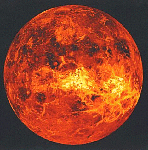Venus
 Venus is our nearest planetary neighbour, and was the first planet
to be explored. It was named after the Greek goddess of love and beauty
due to its brightness. Venus is similar to Earth in terms of size, mass
and density, but that is where the similarities end. Venus' atmosphere
is made up mostly of carbon dioxide, and it acts similarly to a greenhouse,
allowing solar radiation to reach the surface, but trapping most of the
heat in. The effect of this is an average surface temperature of 482°C.
Besides of this high temperature, Venus also has winds that reach up to
350km/h, and an atmospheric pressure 90 times that of Earth, which is
equivalent to the pressure at the depth of 1km in our oceans.
Venus is our nearest planetary neighbour, and was the first planet
to be explored. It was named after the Greek goddess of love and beauty
due to its brightness. Venus is similar to Earth in terms of size, mass
and density, but that is where the similarities end. Venus' atmosphere
is made up mostly of carbon dioxide, and it acts similarly to a greenhouse,
allowing solar radiation to reach the surface, but trapping most of the
heat in. The effect of this is an average surface temperature of 482°C.
Besides of this high temperature, Venus also has winds that reach up to
350km/h, and an atmospheric pressure 90 times that of Earth, which is
equivalent to the pressure at the depth of 1km in our oceans.
Venus, like most terrestrial planets is basically broken up into two geographical categories - highland and lowland. Both areas contain a relatively high level of volcanic activity, having around 156 volcanoes larger than 100km in diameter, and around 580 smaller ones. Scientists believe that many of these volcanoes are still active, and this suggests that Venus' surface is made up largely of igneous rock.
|
Diameter |
12, 103.6 km |
|
Mass |
48.7 × 1023 kg |
|
Mean Distance from sun |
108, 200, 000 km |
|
Mean Density |
5.25 g/cm3 |
|
Rotational Period |
243 Earth days |
|
Orbital Period |
224 Earth days |
|
Mean Orbital Velocity |
35 km/s |
|
Atmosphere |
96.5% carbon dioxide, 3.5% nitrogen |
|
Average Surface Temperature |
482°C |
|
Equatorial Surface Gravity |
8.6 m/s2 |
| Copyright owned by the State of Victoria (Department of Education and Early Childhood Development). Used with Permission. |
|
|||||||||||||||||||||||||||||||||||||||||||||||||||||||||||||||||||||||||||||||||||||